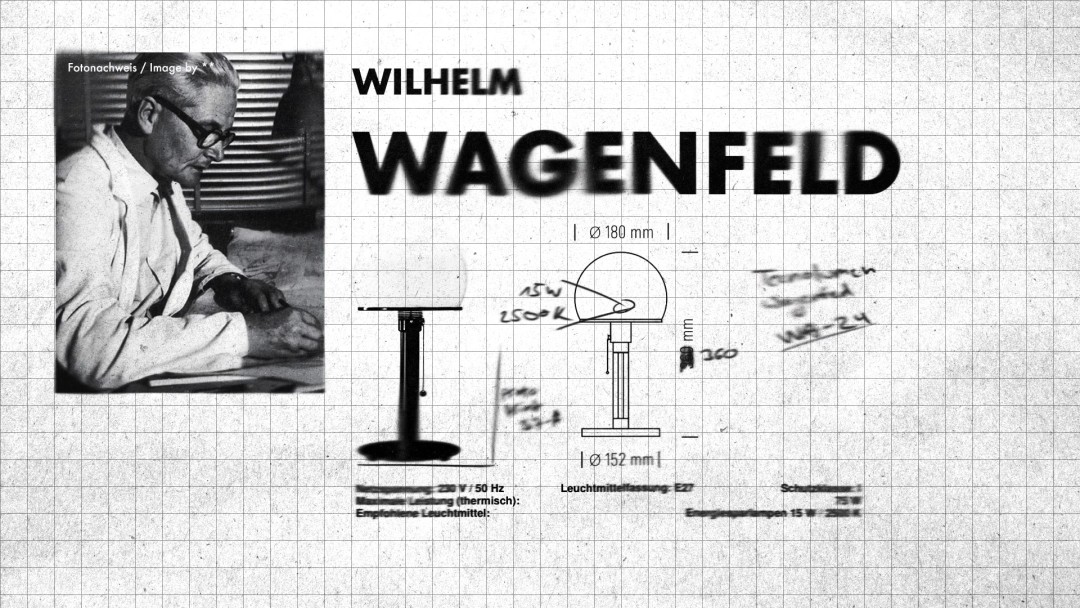available
 Tecnolumen Wagenfeld WA 24 table lamp
Tecnolumen Wagenfeld WA 24 table lamp available
 Tecnolumen Wagenfeld WG 24 table lamp
Tecnolumen Wagenfeld WG 24 table lamp Timeless Bauhaus design
Wilhelm Wagenfeld was born on April 15, 1900 in Bremen and died on May 28, 1990 in Stuttgart. He grew up in Bremen in a politically active and social-democratic parental home. In 1914 he began his apprenticeship as an industrial draftsman at the Koch & Bergfeld silverware factory in Bremen. From 1916 to 1919 Wagenfeld attended the Bremen State School of Arts and Crafts, at times parallel to his apprenticeship. He then attended the Hanau Drawing Academy and subsequently spent some time at the artists' colony in Worpswede. The designer attended a preliminary class at the Bauhaus in Weimar from 1923 and studied there in the metal workshop. After completing his journeyman's examination as a chaser and silversmith in 1926, he became an assistant in the metal workshop at the State Building College in Weimar. From 1928 Wilhelm Wagenfeld took over the management of the metal workshop there. During his time as a freelancer at the Schott glassworks in Jena, he created famous designs such as the tea service made of fireproof glass. From 1931 to 1935 Wagenfeld held a professorship at the Staatliche Kunsthochschule in Berlin. He then held the artistic directorship of the Lausitzer Glaswerke. During World War II, Wagenfeld refused to join the NSDAP and did not carry out ordered design commissions from the SS. In the meantime, the designer worked for industrial companies such as the Fürstenberg porcelain manufactory and the Rosenthal company. After the designer returned home from Soviet captivity in 1945, he became a professor at the Hochschule für Bildende Künste in Berlin. Then in 1954 he founded his own workshop in Stuttgart, which he operated until 1978.
The Wagenfeld lamp and other classics
The design for Wagenfeld's famous table lamp originated in 1924. Under his teacher László Moholy-Nagy at the Bauhaus, the designer developed the designs for the lamps MT 8, the metal version, and MT 9, the glass version. These designs later became known as Wagenfeld lamps and are still Wilhelm Wagenfeld's most famous designs. In 1925 Wagenfeld was able to make some technical innovations to the glass version of the lamp and patented it. He developed it further and manufactured it. At the same time there was still the old production of the lamps at the Bauhaus Dessau. The lamp was given a lampshade made of opal glass, which caused an even distribution of light. The designs of Wilhelm Wagenfeld are characterized by the functionality and timeless appearance. His preferred materials were mainly glass and metal. Even today, many of his more than 600 designs are titled as design classics and are still being produced. Tecnolumen is the only manufacturer worldwide to produce licensed replicas of the original Wagenfeld lamps. Wilhelm Wagenfeld particularly followed the typical Bauhaus motto "form follows function". The functionality of his designs was always particularly important to him. He wanted his designs to reach poorer classes as well. For him, good material and thorough workmanship counted, so Wilhelm Wagenfeld guaranteed functionality and durability.
** Image: https://www.prooffice.de/artikel/wilhelm-wagenfeld-pionier-des-industriedesigns.html

